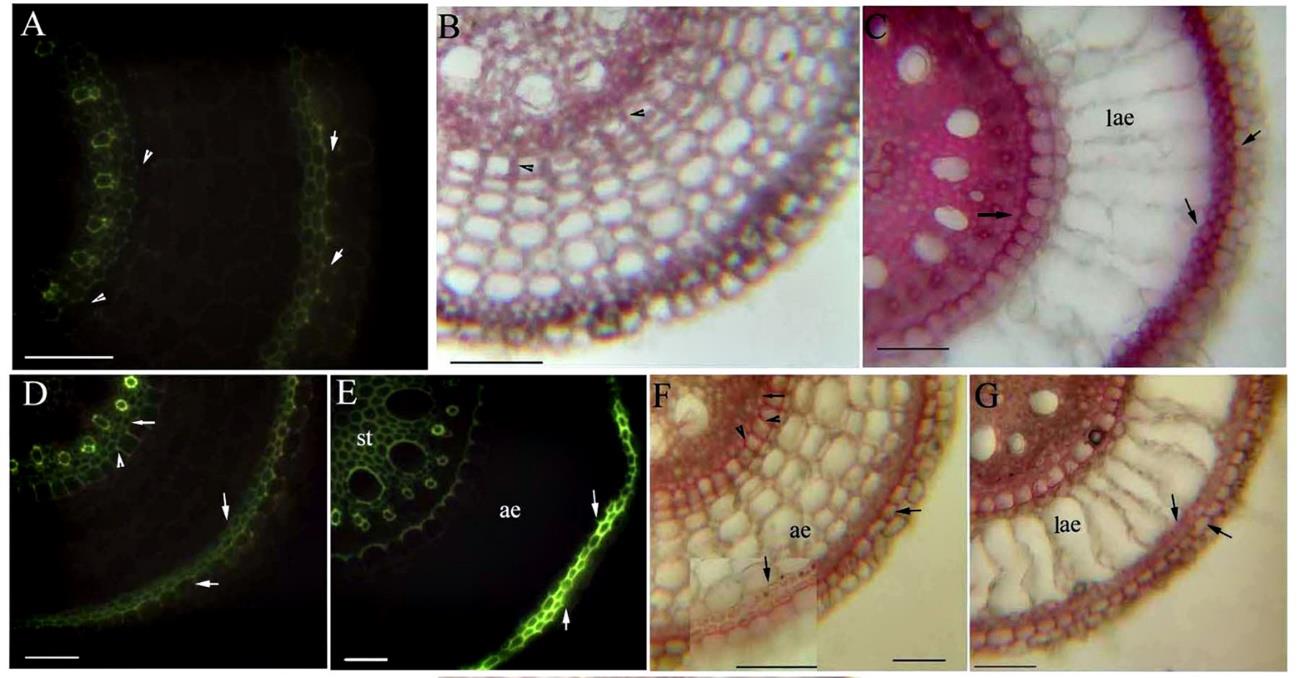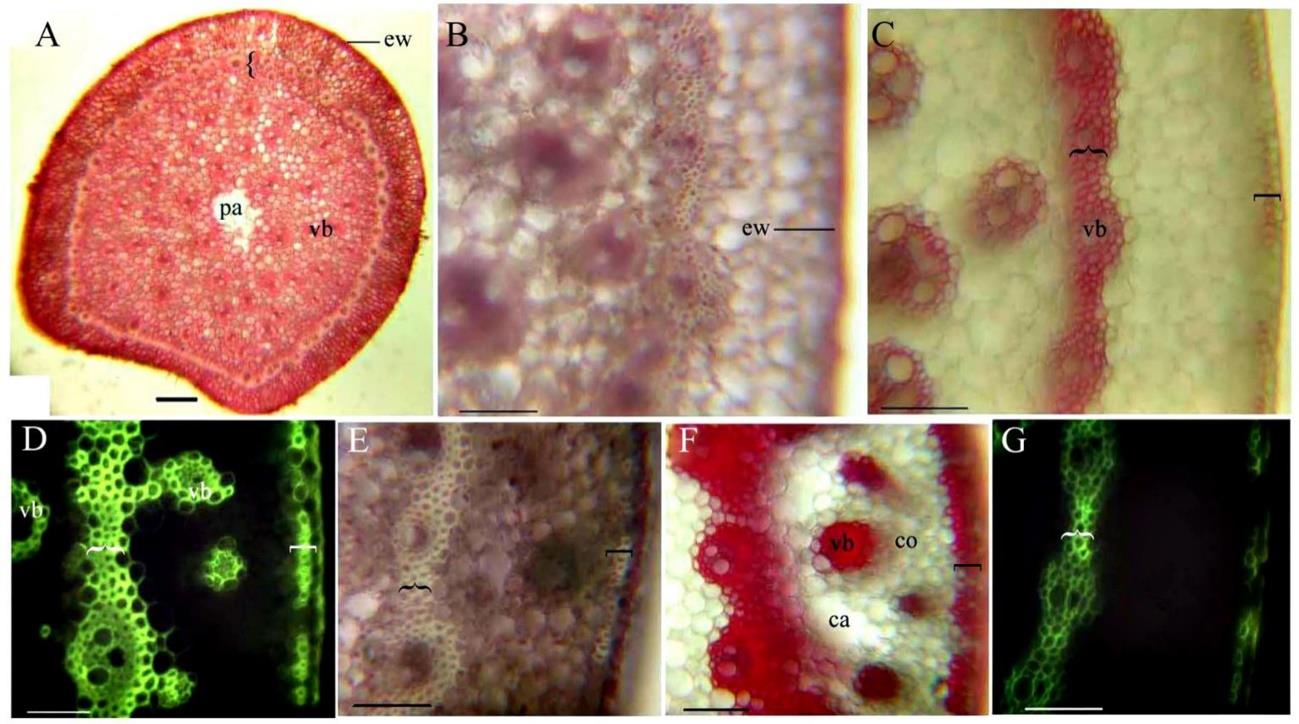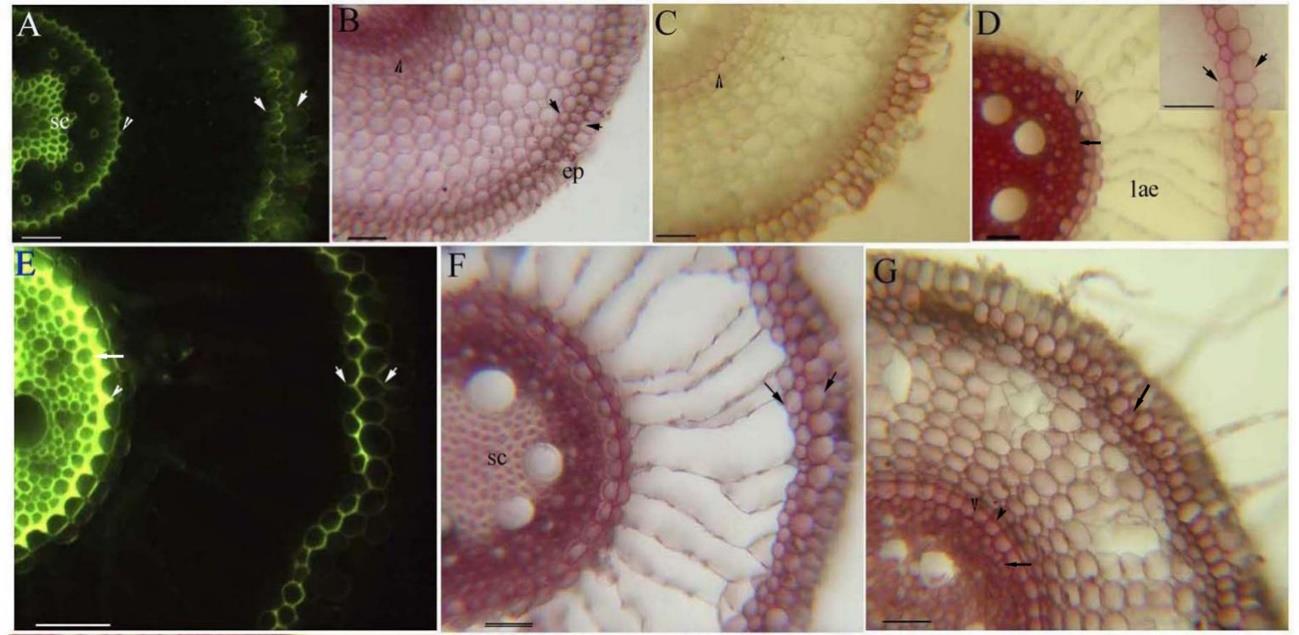

ISSN 1004-5759 CN 62-1105/S


草业学报 ›› 2024, Vol. 33 ›› Issue (10): 46-54.DOI: 10.11686/cyxb2023453
秦格格1( ), 韩炼2, 何心雨1, 王玉生1, 任凡1, 陈兹舜2, 周存宇1, 杨朝东1, 谭德宝3, 张霞1(
), 韩炼2, 何心雨1, 王玉生1, 任凡1, 陈兹舜2, 周存宇1, 杨朝东1, 谭德宝3, 张霞1( )
)
收稿日期:2023-11-27
修回日期:2024-01-31
出版日期:2024-10-20
发布日期:2024-07-15
通讯作者:
张霞
作者简介:Corresponding author. E-mail: 1584385415@qq.com基金资助:
Ge-ge QIN1( ), Lian HAN2, Xin-yu HE1, Yu-sheng WANG1, Fan REN1, Zi-shun CHEN2, Cun-yu ZHOU1, Chao-dong YANG1, De-bao TAN3, Xia ZHANG1(
), Lian HAN2, Xin-yu HE1, Yu-sheng WANG1, Fan REN1, Zi-shun CHEN2, Cun-yu ZHOU1, Chao-dong YANG1, De-bao TAN3, Xia ZHANG1( )
)
Received:2023-11-27
Revised:2024-01-31
Online:2024-10-20
Published:2024-07-15
Contact:
Xia ZHANG
摘要:
假俭草和牛鞭草是2种分布于江汉平原地区并能在旱生和水湿环境中生长的湿地植物,适应江汉平原地区的季节性洪水,在长江流域各种退化湿地和消落带的植被修复中耐水淹植物的筛选发挥重要作用。为探索假俭草和牛鞭草环境适应性结构(通气组织和质外体屏障结构)和解剖结构差异所体现的耐水淹能力倾向,研究了两个物种根、茎解剖结构与组织化学特性。运用植物解剖切片法、组织化学染色定位法,在显微镜下观察拍照,结果表明:1) 假俭草和牛鞭草具有适应湿地环境的解剖结构特征,是典型的湿地植物。这些结构特征包括通气组织(茎部气腔和根部裂-溶生性通气组织)和质外体屏障(内皮层、外皮层、栓质化组织和角质层)等。假俭草和牛鞭草的不定根都具有内皮层和外皮层,其细胞壁上都有木栓质和木质素沉积。2) 牛鞭草的茎具有栓质化和木质化周缘厚壁机械组织层和维管束鞘细胞以及髓腔;而假俭草的茎仅有木质化周缘厚壁机械组织层、厚壁机械组织环和维管束鞘细胞,以及髓腔和皮层气腔。牛鞭草匍匐茎和根状茎均具连续的栓质化周缘厚壁机械组织层和维管束鞘,而假俭草匍匐茎的周缘厚壁机械组织层仅木质化且是不连续的,从而推测牛鞭草比假俭草适应更高强度的淹没环境。
秦格格, 韩炼, 何心雨, 王玉生, 任凡, 陈兹舜, 周存宇, 杨朝东, 谭德宝, 张霞. 湿地植物假俭草和牛鞭草的解剖结构和组织化学特性研究[J]. 草业学报, 2024, 33(10): 46-54.
Ge-ge QIN, Lian HAN, Xin-yu HE, Yu-sheng WANG, Fan REN, Zi-shun CHEN, Cun-yu ZHOU, Chao-dong YANG, De-bao TAN, Xia ZHANG. Anatomical and histochemical features of the wetland plants Eremochloa ophiuroides and Hemarthria altissima[J]. Acta Prataculturae Sinica, 2024, 33(10): 46-54.

图1 假俭草不定根的结构A: 距根尖5 mm处,内皮层凯氏带 (箭头);外皮层凯氏带 (右二箭);BAB染色。B: 内皮层(箭头);皮层一些薄壁细胞裂生为通气组织;SR7B染色。C: 中柱鞘(左箭);外皮层次生壁木质化(右二箭);位于皮层的溶生性通气组织和一些残余的细胞;Pg染色。D: 外皮层木质化次生壁(下位二箭);中柱鞘(上位细箭);内皮层(箭头);BAB染色。E: 外皮层木质化次生壁(二箭),中柱木质部细胞壁增厚;BAB染色。F: 距根尖25 mm处;内皮层栓质化层(二箭头);中柱鞘(上位细箭);外皮层栓质化层(靠右箭);皮层细胞裂生为通气组织(箭靠近ae);SR7B染色。G: 外皮层栓质化层(右箭)和次生壁(左箭);溶生通气组织,皮层细胞完全溶解;SR7B染色。ae,通气组织;lae,溶生性通气组织;st,中柱;BAB,硫酸氢黄连素-苯胺蓝;SR7B,苏丹红;Pg,盐酸-间苯三酚;下同。比例尺=50 μm。A: Endodermis Casparian bands (arrowheads), at the root tip 5 mm; Exodermis Casparian bands (right two arrows); BAB. B: Endodermis (arrowheads); Some parenchyma cells in the cortex were schizogeny into aerenchyma; SR7B. C: Pericycle (left arrows); Exodermis with lignified secondary walls (right two arrows); Lysigenous aerenchyma and some residual cells located in the cortex; Pg. D: Exodermis with lignified secondary walls (two arrows lower); Pericycle (top thin arrow); Endodermis (arrowhead); BAB. E: Exodermis lignified secondary walls (two arrows); Stele xylem cells with thickened walls; BAB. F: Endodermis suberin lamellae (two arrowheads), at the root tip 25 mm; Pericycle (top thin arrows); Exodermis suberin lamellae (right arrows); Cortical cells split into aerenchyma (arrow near ae); SR7B. G: Exodermis suberin lamellae (arrow on the right) and secondary walls (arrow on the left); Lysigenous aerenchyma, all cortical plates collapsed; SR7B. ae, Aerenchyma; lae, Lysigenous aerenchyma lacuna; st, Stele; BAB, Berberine aniline blue; SR7B, Sudan red 7B; Pg, Phloroglucinol-HCl; The same below. Scale bar=50 μm.
Fig. 1 Structure of adventitious roots of E. ophiuroides

图2 假俭草匍匐茎的结构A~G:匍匐茎(213 mm长,17节);切片幼年匍匐茎第1节间,成年匍匐茎第8节间。A: 成年匍匐茎,表皮内侧周缘厚壁机械组织层(大括号);厚壁机械组织环内侧有分散的维管束,苏丹红Ⅲ染色。B: 幼年匍匐茎;表皮外具厚壁,无厚壁机械组织环栓质化,SR7B染色。C: 幼年匍匐茎;表皮;不连续木质化单层细胞周缘厚壁机械组织层(中括号);厚壁机械组织环(大括号)并具有嵌入的维管束大量木质素沉积,Pg染色。D: 成年匍匐茎;不连续木质化周缘厚壁机械组织层(中括号);皮层具维管束;具有强烈木质化和嵌入维管束的厚壁机械组织环(大括号),BAB染色。E: 成年匍匐茎;不连续木质化周缘厚壁机械组织层(中括号);厚壁机械组织环(大括号),SR7B染色。F: 成年匍匐茎;皮层具有不规则溶生性通气组织和维管束;不连续木质化周缘厚壁机械组织层(中括号),Pg染色。G: 幼年匍匐茎;厚壁机械组织环具内嵌维管束(大括号);不连续木质化周缘厚壁机械组织层,BAB染色。ca,气腔;co,皮层;ew,表皮细胞壁;pa,髓腔;vb,维管束。下同。比例尺=100 μm。A~G: Creeping stem (213 mm long, 17 segments); Young stolons were sliced between the first node and between the 8th nodes of the stolon. A: Aged stolon; Epidermis peripheral mechanical ring (brace); Scattered vascular bundles in sclerenchyma ring; Sudan Ⅲ. B: Young stolon; Thick epidermal walls; No suberin walls in cortex or sclerenchyma ring. SR7B. C: Young stolon; Epidermis; Peripheral mechanical ring lignify and interrupted uniseriate layer (bracket); Sclerenchyma ring (brace) thicker with embedded vascular bundles and heavy lignin, Pg. D: Aged stolon; Interrupted peripheral mechanical ring (bracket); Cortex with vascular bundles; sclerenchyma ring (brace) with heavy lignin and embedded vascular bundles, BAB. E: Aged stolon; Interrupted peripheral mechanical ring (bracket); Sclerenchyma ring (brace), SR7B. F: Aged stolon; Cortex with irregular lysigenous aerenchyma and vascular bundles; Interrupted peripheral mechanical ring at right, Pg. G: Young stolon; Sclerenchyma ring (brace) with embedded vascular bundles; Interrupted lignified peripheral mechanical ring, BAB. ca, Cortical cavities; co, Cortex; ew, Epidermal cell wall; pa, Pith cavity; vb, Vascular bundle. The same below. Scale bar=100 μm.
Fig. 2 Structure of the creeping stolon of E. ophiuroides

图3 牛鞭草不定根的结构A~G:不定根(200 mm长);A: 距根尖5 mm处,内皮层凯氏带(靠近sc的箭头);外皮层凯氏带(右二箭);木质部厚壁细胞;BAB染色。B: 内皮层栓质化(箭头);外皮层栓质化(靠近ep二箭);SR7B染色。C: 距根尖25 mm处,木质化内皮层(箭头);Pg染色。D: 中柱鞘(细箭),内皮层马蹄形增厚次生壁(箭头);外皮层木质化(右二箭);薄壁细胞溶解成通气组织;Pg染色。E: 中柱鞘(细箭),内皮层具有马蹄形增厚的次生壁(箭头);木质化外皮层(右二箭);染色BAB。F:外皮层具3层细胞强烈栓质化(二箭);通气组织;髓;染色SR7B。G: 中柱鞘(低细箭),内皮层(箭头)和木质化外皮层(高细箭) 具薄次生细胞壁;SR7B染色。ep,表皮;sc,厚壁组织。下同。比例尺=50 μm。A~G: Adventitious roots (200 mm long); A: Endodermis Casparian bands (arrowhead near sc), at the root tip 5 mm; Exodermis with Casparian bands (right two arrows); Xylem sclerenchyma; BAB. B: Endodermis with suberin lamellae (arrowhead); Exodermis with suberin lamellae (two arrows near ep); SR7B. C: Endodermis with lignin (arrowhead), at the root tip 25 mm; Pg. D: Pericycle (thin arrow), endodermis with U-shaped walls (arrowhead); Exodermis lignified (right two arrows); Collapse of parenchyma cells form the aerenchyma; Pg. E: Pericycle (thin arrow), endodermis with U-shaped walls (arrowhead); Lignify exodermis (right two arrows);BAB. F: Hypodermis 3-layered at maturity with suberin lamellae (two arrows); Aerenchyma; Pith; SR7B. G: Pericycle (lowest thin arrow), endodermis (arrowhead) and lignification exodermis (top thin arrow) with thin secondary cell walls; SR7B. ep, Epidermis; sc, Sclerenchyma. The same below. Scale bars=50 μm.
Fig. 3 Structure of adventitious roots of H. altissima

图4 牛鞭草茎的结构A: 成熟的匍匐茎;周缘厚壁机械组织层(中括号),无厚壁机械组织环;大的髓腔和散布在薄壁组织中维管束;苏丹红Ⅲ染色。B: 年幼的匍匐茎;周缘厚壁机械组织层(中括号)并含同化组织;插入图为维管束鞘栓质化;SR7B染色。C: 年幼的匍匐茎;木质化周缘厚壁机械组织层(中括号);Pg染色。D: 成熟的匍匐茎;具维管束的木质化周缘厚壁机械组织层(中括号);BAB染色。E: 成熟的匍匐茎;周缘厚壁机械组织层内部镶嵌有含叶绿体的同化组织;维管束具栓质化的维管束鞘;厚角组织细胞(星号);BAB染色。F: 成熟的根状茎(50 mm,8节)在第5节间切片;周缘厚壁机械组织层(中括号);厚壁机械组织环(大括号)内镶嵌维管束;大髓腔;Pg染色。G: 成熟的匍匐茎;厚角组织细胞(星号);Pg染色。chl,薄壁组织;pa,髓腔。比例尺=100 μm。A: Aged stolon; Peripheral mechanical ring (bracket), no sclerenchyma ring; Scattered vascular bundles and large pith cavity; Sudan Ⅲ. B: Young stolon; Peripheral mechanical ring (bracket) with embedded chlorenchyma; The inserted image shows the suberized vascular bundle sheath; SR7B. C: Young stolon; Lignified peripheral mechanical ring (bracket); Pg; D: Aged stolon; Lignified peripheral mechanical ring (bracket) embedded vascular bundle; BAB. E: Aged stolon; Peripheral mechanical ring (bracket) with chlorenchyma containing chloroplasts; Vascular bundle with suberization vascular bundle sheath; Collenchymatous cells walls (asterisks) ; BAB. F: Aged rhizome (50 mm, 8 segments) slice between 5th segments; Peripheral mechanical ring (bracket); Sclerenchyma mechanical ring (brace) with embedded vascular bundles; Large pith cavity; Pg. G: Aged stolon; Collenchymatous cell walls (asterisk); Pg; chl, Chlorenchyma; pa, Pith cavity. Scale bar=100 μm.
Fig. 4 Structure of the stem of H. altissima
| 结构Structures | 假俭草E. ophiuroides | 牛鞭草H. altissima |
|---|---|---|
| 不定根内皮层Endodermis of adventitious roots | 细胞壁呈马蹄形增厚,具凯氏带U-shaped thicken of the cell wall, and with Casparian bands | 细胞壁呈马蹄形增厚,具凯氏带U-shaped thicken of the cell wall, and with Casparian bands |
| 外皮层Exodermis | 增厚的单层细胞,具凯氏带 Thicken uniseriate cells layer, and with Casparian bands | 增厚的双层细胞,具凯氏带Thicken biseriate cells layer, and with Casparian bands |
| 中柱Stele | 35~40个原生木质部,厚壁细胞近原生木质部和后生木质部35-40 protoxylem, sclerenchyma near protoxylem and metaxylem | 14~16个原生木质部,木质部厚壁细胞14-16 protoxylem, xylem sclerenchyma |
| 根部通气组织Root aerenchyma | 裂-溶生性通气组织Schizo-lysogenic aerenchyma | 裂-溶生性通气组织Schizo-lysigenouaerenchyma |
| 内皮层和外皮层Endodermis and exodermis | 木栓质和木质素沉积Suberin and lignin deposition | 木栓质和木质素沉积Suberin and lignin deposition |
| 水平茎Stem | 匍匐茎Stolons | 匍匐茎,根状茎Stolons, rhizomes |
| 茎部通气组织Stem aerenchyma | 髓腔、皮层气腔Pith cavity, cortical aerenchyma | 髓腔Pith cavity |
| 周缘机械组织层Peripheral mechanical ring | 不连续、仅木质化Discontinuous, only lignified | 连续、栓质化,内含同化组织(匍匐茎)和维管束Continuous, suberized layers, chlorenchyma in stolons, and vascular bundle sheath |
| 厚壁机械组织环Sclerenchyma ring | 木质化Lignified | 木质化 (根状茎),匍匐茎中未发现Lignified sclerenchyma ring in rhizomes, absent in stolons |
表1 假俭草和牛鞭草的解剖和组织化学特性比较
Table 1 Comparison of anatomy and histochemistry of E. ophiuroides and H. altissima
| 结构Structures | 假俭草E. ophiuroides | 牛鞭草H. altissima |
|---|---|---|
| 不定根内皮层Endodermis of adventitious roots | 细胞壁呈马蹄形增厚,具凯氏带U-shaped thicken of the cell wall, and with Casparian bands | 细胞壁呈马蹄形增厚,具凯氏带U-shaped thicken of the cell wall, and with Casparian bands |
| 外皮层Exodermis | 增厚的单层细胞,具凯氏带 Thicken uniseriate cells layer, and with Casparian bands | 增厚的双层细胞,具凯氏带Thicken biseriate cells layer, and with Casparian bands |
| 中柱Stele | 35~40个原生木质部,厚壁细胞近原生木质部和后生木质部35-40 protoxylem, sclerenchyma near protoxylem and metaxylem | 14~16个原生木质部,木质部厚壁细胞14-16 protoxylem, xylem sclerenchyma |
| 根部通气组织Root aerenchyma | 裂-溶生性通气组织Schizo-lysogenic aerenchyma | 裂-溶生性通气组织Schizo-lysigenouaerenchyma |
| 内皮层和外皮层Endodermis and exodermis | 木栓质和木质素沉积Suberin and lignin deposition | 木栓质和木质素沉积Suberin and lignin deposition |
| 水平茎Stem | 匍匐茎Stolons | 匍匐茎,根状茎Stolons, rhizomes |
| 茎部通气组织Stem aerenchyma | 髓腔、皮层气腔Pith cavity, cortical aerenchyma | 髓腔Pith cavity |
| 周缘机械组织层Peripheral mechanical ring | 不连续、仅木质化Discontinuous, only lignified | 连续、栓质化,内含同化组织(匍匐茎)和维管束Continuous, suberized layers, chlorenchyma in stolons, and vascular bundle sheath |
| 厚壁机械组织环Sclerenchyma ring | 木质化Lignified | 木质化 (根状茎),匍匐茎中未发现Lignified sclerenchyma ring in rhizomes, absent in stolons |
| 1 | Li S D. Ecological environment in the Yangtze River valley and sustainable development. Research of Soil and Water Consenation, 1999, 6(4): 15-18. |
| 李树德. 长江流域生态环境与可持续发展. 水土保持研究, 1999, 6(4): 15-18. | |
| 2 | Zhang J C, Peng B Z. Study on riparian zone and the restoration and rebuilding of its degraded ecosystem. Acta Ecologica Sinica, 2003, 23(1): 56-63. |
| 张建春, 彭补拙. 河岸带研究及其退化生态系统的恢复与重建. 生态学报, 2003, 23(1): 56-63. | |
| 3 | Zhong R H, He X B, Bao Y H, et al. Role of Cynodon dactylon L. and Hemarthria altissima in wave attenuation and erosion control.Transactions of the Chinese Society of Agricultural Engineering, 2015, 31(2): 133-140. |
| 钟荣华, 贺秀斌, 鲍玉海, 等. 狗牙根和牛鞭草的消浪减蚀作用. 农业工程学报, 2015, 31(2): 133-140. | |
| 4 | Xu S, Zhang X Q, Wu Y Q, et al. Review on study and application of Hemarthria. Grassland of China, 2001, 23(4): 54-59. |
| 徐胜, 张新全, 吴彦奇, 等. 牛鞭草研究与应用概况. 中国草地, 2001, 23(4): 54-59. | |
| 5 | Liu Y M, Xun H F, Ding X P, et al. Evaluation of salinity tolerance of 55 centipede grass ecotypes. Pratacultural Science, 2017, 34(11): 2261-2271. |
| 刘一明, 郇恒福, 丁西朋, 等. 55份不同生态型假俭草的耐盐性评价. 草业科学, 2017, 34(11): 2261-2271. | |
| 6 | Vervuren P J A, Blom C, Kroon H D. Extreme flooding events on the Rhine and the survival and distribution of riparian plant species. Journal of Ecology, 2003, 91(1): 135-146. |
| 7 | Finlayson C M. Plant ecology of Australia’s tropical floodplain wetlands: A review. Annals of Botany, 2005, 96(4): 541-555. |
| 8 | Glenz C, Schlaepfer R, Kierast R. Flooding tolerance of Central European tree and shrub species. Forest Ecology and Management, 2006, 235(1/3): 1-13. |
| 9 | DeSimone, Muller E, Junk W J, et al. Adaptations of Central Amazon tree species to prolonged flooding: root morphology and leaf longevity. Plant Biology, 2002, 4(4): 515-522. |
| 10 | Parolin P. Submerged in darkness: Adaptations to prolonged submergence by woody species of the Amazonian floodplains. Annals of Botany, 2009, 103(2): 359-376. |
| 11 | Parolin P, De Simone O, Haase K, et al. Central Amazonian floodplain forests: Tree adaptations in a pulsing system. Botanical Review, 2004, 70(3): 357-380. |
| 12 | Parolin P, Armbruster N, Junk W J. Two Amazonian floodplain trees react differently to periodical flooding. Tropical Ecology, 2006, 47(2): 243-250. |
| 13 | Armstrong J, Armstrong W. Rice and phragmites: Effect of organic acids on growth, root permeability, and radial oxygen loss to the rhizosphere. American Journal Botany, 2001, 88(8): 1359-1371. |
| 14 | Engloner A I. Structure, growth dynamics and biomass of reed (Phragmites australis)-A review. Flora, 2009, 204(5): 331-346. |
| 15 | Engloner A I, Gubeso G. Histological investigations of reed in Ingóiberek (Kis-Balaton Reservoir System). Botanikai Közleményck, 2001, 88(1): 39-47. |
| 16 | Jackson M B, Colmer T D. Response and adaptation by plants to flooding stress. Annals of Botany, 2005, 96(4): 501-505. |
| 17 | Justin S H, Armstrong W. The anatomical characteristics of roots and plant response to soil flooding. New Phytologist, 1987, 106(3): 465-495. |
| 18 | Kotula L, Steudle E. Measurements of oxygen permeability coefficient of rice (Oryza sativa L.) roots using a new perfusion technique. Journal of Experimental Botany, 2009, 60(2): 567-580. |
| 19 | Soukip A, Votrubova O, ˇCíˇZLOVá H. Development of anatomical structure of roots of Phragmites australis. New Phytologist, 2002, 53(2): 277-287. |
| 20 | Zhang X, Hu L J, Zhou C Y, et al. Studies on anatomy and apoplastic barrier histochemistry characters of Oenanthe javanica (BI.)DC. adapted to wetland environment. China Vegetables, 2016, 1(7): 52-58. |
| 张霞, 胡露洁, 周存宇, 等. 水芹适应湿地环境的解剖和屏障结构组织化学特征研究. 中国蔬菜, 2016, 1(7): 52-58. | |
| 21 | Colmer T D, Gibberd M R, Wiengweera A, et al. The barrier to radial oxygen loss from roots of rice (Oryza sativa L.) is induced by growth in stagnant solutions. Journal of Experimental Botany, 1998, 49(325): 1431-1436. |
| 22 | Armstrong J, Armstrong W, Beckett P M, et al. Pathways of aeration and the mechanisms and beneficial effects of humidity- and venturi-induced convections of Phragmites australis (Cav.) Trin. ex Steud. Aquatic Botany, 1996, 54(2/3): 177-197. |
| 23 | Metcalfe C R. Anatomy of the Monocotyledons. I. Gramineae. London, Oxford: Clarendon Press, 1960, 133(3467): 1817-1818. |
| 24 | Soukup A, Voukupva O, ˇCíˇZková H. Internal segmentation of rhizomes of Phragmites australis: protection of the internal aeration system against being flooded. New Phytologist, 2000, 145(1): 71-75. |
| 25 | Sangster A G. Silicon distribution and anatomy of the grass rhizome, with special reference to Miscanthus sacchariflorus (Maxim.) Hackel. Annals of Botany, 1985, 55(5): 621-634. |
| 26 | Jensen W A, Francisco S. Botanical histochemistry-Principles and practice. Science, 1963, 140(3567): 634-635. |
| 27 | Brundrett M C, Kendrick B, Peterson C A. Efficient lipid staining in plant material with Sudan red 7B or Fluorol yellow 088 in polyethylene glycol-glycerol. Biotechnic Histochem, 1991, 66(3): 111-116. |
| 28 | Brundrett M C, Enstpne D E, Peterson C A. A berberine-aniline blue fluorescent staining procedure for suberin, lignin and callose in plant tissue. Protoplasma, 1988, 146(2): 133-142. |
| 29 | Soukup A, Armstrong W, Schreiber L, et al. Apoplastic barriers to radial oxygen loss and solute penetration: A chemical and functional comparison of the exodermis of two wetland species, Phragmites australis and Glyceria maxima. New Phytologist, 2007, 173(2): 264-278. |
| 30 | Ranathunge K, Lin J X, Steudle E, et al. Stagnant deoxygenated growth enhances root suberization and lignifications, but differentially affects water and NaCl permeabilities in rice (Oryza sativa L.) roots. Plant Cell Environment, 2011, 34(8): 1223-1240. |
| 31 | Zhang X, Yang C D, Ning G G. The developmental comparison of apoplastic barriers in Cynodon dactylon and Paspalum distichum roots. Hubei Agricultural Sciences, 2013, 52(20): 4991-4994. |
| 张霞, 杨朝东, 宁国贵. 狗牙根和双穗雀稗根中质外体屏障结构发育过程的比较研究. 湖北农业科学, 2013, 52(20):4991-4994. | |
| 32 | Yang C D, Zhang X, Li J K, et al. Anatomy and histochemistry of roots and shoots in wild rice (Zizania latifolia Griseb.). Journal of Botany, 2014, 2014(1): 1-9. |
| 33 | Yang C D, Li S F, Deng S M, et al. Study of the anatomy and apoplastic barrier characteristics of Imperata cylindrica. Acta Prataculturae Sinica, 2015, 24(3): 213-218. |
| 杨朝东, 李守峰, 邓仕明, 等. 白茅解剖结构和屏障结构特征研究. 草业学报, 2015, 24(3): 213-218. | |
| 34 | Wang X E, Zhang F, Zhang X, et al. Anatomy and histochemistry features of Phalaris arundinacea adapted to wetland environments. Acta Prataculturae Sinica, 2019, 28(1): 86-94. |
| 王晓娥, 张梵, 张霞, 等. 虉草适应湿地环境的解剖结构和组织化学特征研究. 草业学报, 2019, 28(1): 86-94. |
| [1] | 郑海, 王莹, 徐娟, 朱婷婷, 秦格格, 周存宇, 杨朝东, 谭德宝, 张霞, 魏红波. 两栖植物香附子的解剖结构和组织化学研究[J]. 草业学报, 2024, 33(6): 155-164. |
| [2] | 姚瑞瑞, 刘欢, 赵桂琴, 王敬龙, 王绮玉, 董凯, 张然. 贮藏时间对皮、裸燕麦种子萌发及细胞学结构的影响[J]. 草业学报, 2024, 33(2): 154-163. |
| [3] | 谭炯锐, 查同刚, 张泽宇, 张晓霞, 滕红梅, 王玲丽, 赵莉丽, 王奥, 王馨珧. 猪毛菜响应干旱胁迫的叶片结构、生理及转录组分析[J]. 草业学报, 2024, 33(1): 75-88. |
| [4] | 吉轶楠, 任雪锋, 苟甜甜, 臧国长, 郑轶琦. 基于SSR标记的河南省假俭草群体遗传多样性研究[J]. 草业学报, 2023, 32(9): 198-212. |
| [5] | 钱文武, 郭鹏, 朱慧森, 张士敏, 李德颖. 草地早熟禾叶片表皮特征、解剖结构及光合特性对不同施氮量的响应[J]. 草业学报, 2023, 32(1): 131-143. |
| [6] | 董梦宇, 王金鑫, 吴萌, 周子瑶, 程顺, 李彦慧. 两种香花芥属植物叶片结构及光合特性研究[J]. 草业学报, 2022, 31(7): 172-184. |
| [7] | 王贞升, 李彦雪, 于成龙, 狄小琳, 陈鹏, 田静瑶, 王竞红. 不同模拟降水量下草地早熟禾根系形态与解剖结构的动态变化[J]. 草业学报, 2020, 29(10): 70-80. |
| [8] | 陈斌, 李洪瑶, 刘筱玮, 夏斌, 孙绍文, 孙颖, 何淼. 不同光照强度对新娘草叶片形态建成及超微结构的影响[J]. 草业学报, 2019, 28(7): 175-185. |
| [9] | 李小铃, 关皓, 帅杨, 李小梅, 彭安琪, 李昌华, 蒲棋, 闫艳红, 张新全. 单一和复合乳酸菌添加剂对扁穗牛鞭草青贮品质的影响[J]. 草业学报, 2019, 28(6): 119-127. |
| [10] | 张翠梅, 师尚礼, 刘珍, 杨帆, 张振科. 干旱胁迫对不同抗旱性苜蓿品种根系形态及解剖结构的影响[J]. 草业学报, 2019, 28(5): 79-89. |
| [11] | 刘南清, 林绍艳, 沈益新. 假俭草叶片渗透调节物质含量对冬前低温的响应及其与低温伤害的关系[J]. 草业学报, 2019, 28(3): 122-130. |
| [12] | 李晓雪, 李昌晓, 宋虹, 袁中勋. 水淹和密度配置对牛鞭草与狗牙根扦插苗光合作用的影响[J]. 草业学报, 2019, 28(2): 197-206. |
| [13] | 王晓娥, 张梵, 张霞, 周存宇, 杨朝东. 虉草适应湿地环境的解剖结构和组织化学特征研究[J]. 草业学报, 2019, 28(1): 86-94. |
| [14] | 靳军英, 张卫华, 王大可, 寇青青, 运剑苇, 黄建国. 扁穗牛鞭草的水肥耦合效应研究[J]. 草业学报, 2018, 27(1): 106-114. |
| [15] | 张咏梅, 马晖玲, 唐云智. 紫花苜蓿叶片受白粉病菌侵染后结构的变化[J]. 草业学报, 2017, 26(2): 88-94. |
| 阅读次数 | ||||||
|
全文 |
|
|||||
|
摘要 |
|
|||||